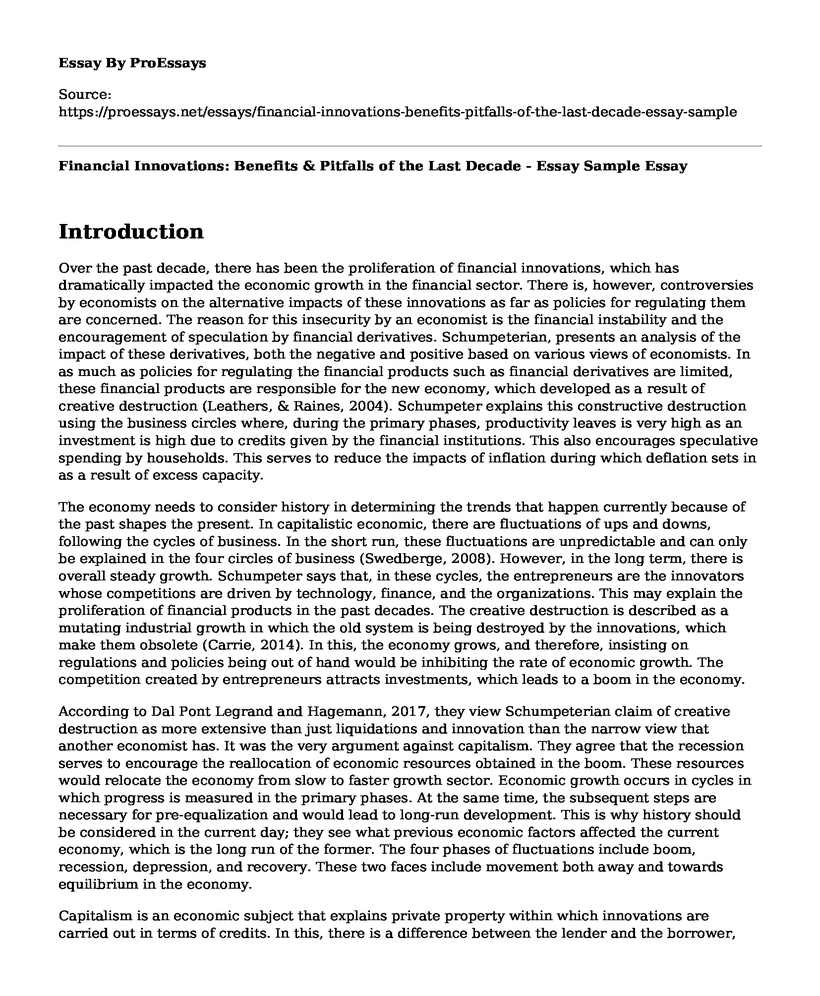Introduction
Over the past decade, there has been the proliferation of financial innovations, which has dramatically impacted the economic growth in the financial sector. There is, however, controversies by economists on the alternative impacts of these innovations as far as policies for regulating them are concerned. The reason for this insecurity by an economist is the financial instability and the encouragement of speculation by financial derivatives. Schumpeterian, presents an analysis of the impact of these derivatives, both the negative and positive based on various views of economists. In as much as policies for regulating the financial products such as financial derivatives are limited, these financial products are responsible for the new economy, which developed as a result of creative destruction (Leathers, & Raines, 2004). Schumpeter explains this constructive destruction using the business circles where, during the primary phases, productivity leaves is very high as an investment is high due to credits given by the financial institutions. This also encourages speculative spending by households. This serves to reduce the impacts of inflation during which deflation sets in as a result of excess capacity.
The economy needs to consider history in determining the trends that happen currently because of the past shapes the present. In capitalistic economic, there are fluctuations of ups and downs, following the cycles of business. In the short run, these fluctuations are unpredictable and can only be explained in the four circles of business (Swedberge, 2008). However, in the long term, there is overall steady growth. Schumpeter says that, in these cycles, the entrepreneurs are the innovators whose competitions are driven by technology, finance, and the organizations. This may explain the proliferation of financial products in the past decades. The creative destruction is described as a mutating industrial growth in which the old system is being destroyed by the innovations, which make them obsolete (Carrie, 2014). In this, the economy grows, and therefore, insisting on regulations and policies being out of hand would be inhibiting the rate of economic growth. The competition created by entrepreneurs attracts investments, which leads to a boom in the economy.
According to Dal Pont Legrand and Hagemann, 2017, they view Schumpeterian claim of creative destruction as more extensive than just liquidations and innovation than the narrow view that another economist has. It was the very argument against capitalism. They agree that the recession serves to encourage the reallocation of economic resources obtained in the boom. These resources would relocate the economy from slow to faster growth sector. Economic growth occurs in cycles in which progress is measured in the primary phases. At the same time, the subsequent steps are necessary for pre-equalization and would lead to long-run development. This is why history should be considered in the current day; they see what previous economic factors affected the current economy, which is the long run of the former. The four phases of fluctuations include boom, recession, depression, and recovery. These two faces include movement both away and towards equilibrium in the economy.
Capitalism is an economic subject that explains private property within which innovations are carried out in terms of credits. In this, there is a difference between the lender and the borrower, the entrepreneur, and the banker (Perez, 2011). Entrepreneurs, unlike bankers, break the walls of economic restrictions to bring new products, unlike the banker who follows systems. In this, the entrepreneurs are the key drivers of creative destruction as they introduce new methods in which the economy is run. Therefore, the modern economy cannot do without innovation, which adds new products like financial derivatives.
References
Carrie, G. (2014). Five: The Rise of Slavery In Empire's Crossroads: A History of the Caribbean from Columbus to Present Day. Macmillan Publishing Company.
Dal Pont Legrand, M., & Hagemann, H. (2017). Retrospectives: Do Productive Recessions Show the Recuperative Powers of Capitalism? Schumpeter's Analysis of the Cleansing Effect. Journal of Economic Perspectives, 31(1), 245-56.
Leathers, C. G., & Raines, J. P. (2004). The Schumpeterian role of financial innovations in the New Economy's business cycle. Cambridge Journal of Economics, 28(5), 667-681.
Swedberg, R. (2008). Prophet of Innovation: Joseph Schumpeter and creative destruction. Technology and Culture, 49(1), 239-240.
Cite this page
Financial Innovations: Benefits & Pitfalls of the Last Decade - Essay Sample. (2023, Jul 05). Retrieved from https://proessays.net/essays/financial-innovations-benefits-pitfalls-of-the-last-decade-essay-sample
If you are the original author of this essay and no longer wish to have it published on the ProEssays website, please click below to request its removal:
- Recommendations on the Consistency of Investment in Tom.com
- Accounting: Organizational Tax and Research Planning Paper Example
- Competitive and Economic Sustainability of Beautonomy Paper Example
- Essay Sample on Christopher Ward Expand to Japan
- Essay Sample on Social Impact of Business
- Global Housing Crisis: Unaffordability a Major Factor in States Like Hawaii - Essay Sample
- Paper Example on Acronyms for Sustainable Development: GDP, GIP, GREET, GTU, LUMP, NEEAP, NUAF, RSS, SA, SEAP, SMSG, UHI







